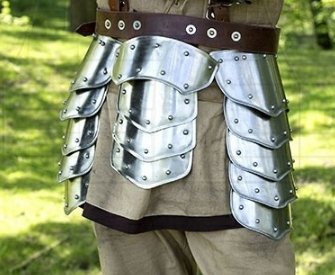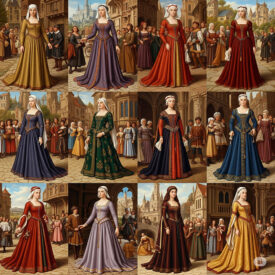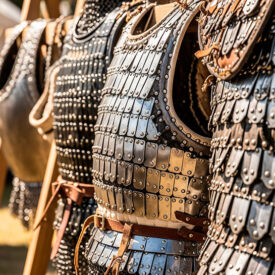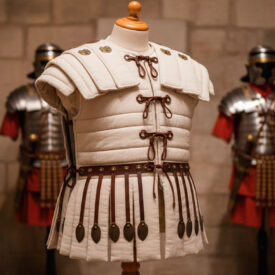Have you ever wondered what protected a knight’s groin when an opponent’s lance struck directly at the side? In the heat of battle, between the breastplate and the cuisses, there was a discreet but essential piece: the escarcela. This kind of metal skirt was born of necessity, technique and the ingenuity of armorers who sought to preserve mobility without sacrificing maximum protection.
What are the Escarcelas of a Medieval Armor?
The escarcelas are metal panels that hang from the lower edge of the breastplate’s skirt to protect the upper thigh area and the hips. Their design ranges from a single rigid plate to several articulated lames that work like a skirt of plates. Their mission was simple but vital: to prevent the point of a lance or the edge of a sword from reaching the groin, an injury that could put any warrior out of action.
Although their shape evolved, the logic behind the escarcela is the same: to cover the junction between torso and lower limbs without impeding basic combat movements.
Escarcelas: historical evolution and functions
The history of the escarcela is a history of adaptation. What began as a reference to a waist pouch in medieval Italy transformed into a technical component of full armor, able to combine protection with mobility.
| Period | Event |
|---|---|
| Origins and early forms (14th–15th centuries) | |
| 14th–15th centuries (term origin) | The term “escarcela” originally referred to a belt pouch in Italy; over time it came to denote the metal piece that protects the upper legs and the hips. |
| 15th century (established use) | Escarcelas were already well established: they were attached to the lower edge of the breastplate (skirt) and especially protected the groin. Their shape resembled a roof tile with a vertical crest; initially they were fastened with nails, a method later replaced by straps and buckles. |
| 15th century (Gothic armors) | Curved and radiating ridges stand out; some armors incorporated two additional small escarcelas to widen thigh coverage. They were commonly made as a single piece. |
| Before 1470 (France) | In France it was common to see four identical escarcelas forming a skirt of plates worn over a mail skirt. |
| Time of Louis XI (mid–late 15th century) | Fluting was added to escarcelas to harmonize them with the breastplate’s skirt, integrating aesthetics and function. |
| Innovation and specialization (16th century) | |
| Early–mid 16th century | They began to be built with articulated pieces (overlapping flaps and internal straps), greatly improving mobility for crouching, turning or handling the weapon without losing protection. |
| Around 1550 (Philip II) | The armor called “the labor of the flowers” included “short escarcelas,” reflecting new design solutions adapted to different uses. |
| 1551 (Philip II, “Burgundy crosses or aspas”) | Escarcelas with a chain mail codpiece; the breastplate and escarcelas were conceived as a single piece in that harness, an image that endured in pictorial representations. |
| 1544–1558 (Inventory of the Royal Armory) | The illuminated inventory shows escarcelas with a final lame with a rounded lower edge, fastened with three straps — a detail that reflects variations in closure and finishing. |
| Late 16th century (pictorial representation) | Portraits such as Pantoja de la Cruz’s (1599), based on Titian, show escarcelas with rounded edges but fastened with hooks instead of straps, suggesting artistic adaptation or the use of pieces different from those inventoried. |
| Use in cavalry and on foot (16th century) | In armors for mounted combat the right escarcela was shorter to make mounting easier; the left was longer and reinforced because it was more exposed. For foot combat there was an additional escarcela attached to the fauld to protect the coccyx. |
| Artistic representations and legacy (16th–17th centuries) | |
| Circa 1630–1640 (Rubens) | In Rubens’ works appear five-piece escarcelas, with the possibility of adding extensions and combining them with half-cuisse articulations, showing technical complexity and variability of use. |
| Circa 1648 (Velázquez) | Portraits attributed to Velázquez show escarcelas with extension lames that allowed lengthening the leg protection; their design and size differ from those represented by Titian and today only the lames of one of them survive. |
| 17th century (legacy) | Escarcelas became part of the symbolism of power and status. Their presence in Baroque art helps us understand their construction, variants and the tension between protection and mobility across centuries. |
Design and construction: materials, geometry and techniques
Escarcelas were forged mainly in steel or carbon iron, worked with hammer and heat treatment to obtain a strong plate. Some ceremonial versions received brass, nickel or gilded decorations, while functional pieces prioritized strength and impact profile.
The geometry of an escarcela responds to two contradictory needs: to deflect impacts and to allow movement. That is why you frequently see:
- Edges and fluting: ribs that strengthen the plate and deflect blows.
- Articulated lames: overlapping pieces that offer flexibility.
- Reinforcements on the exposed side: in rider armors the left escarcela is often more reinforced.
Manufacturing process (summary)
Forging the plate, annealing and tempering to give hardness; shaping by hammering and molding; drilling for rivets and straps; finishing with polishing or patina depending on use. Internal joins were usually protected to prevent chafing with leather or cloth padding.
Escarcelas for foot combat vs. mounted combat
The design adapts to the use. On foot, the priority is overall mobility and frontal protection; on horseback, the rider needs freedom to mount and to receive blows from different angles.
| Aspect | Foot combat | Mounted combat |
|---|---|---|
| Typical length | Balanced to cover the thighs without limiting long strides. | Asymmetric: left longer and reinforced; right shorter for mounting. |
| Articulation | Articulated lames for crouching and sliding. | Sturdier articulation on the left side; sometimes solid pieces. |
| Extra protection | Additional escarcela on the fauld to protect the coccyx. | Reinforcements and flaps to protect the exposed thigh in lances and tournaments. |
Why asymmetry: tactical reasons
In tournaments and mounted combats the rider’s body was turned toward the opponent on the left; therefore that area bore more impacts. The longer, stiffer left escarcela provided extra defence without penalizing the lance action.
Adjustment and fastening: straps, hooks and rivets
The first method was relatively crude: nailing them to the breastplate. Later, straps with buckles, rivets and hooks allowed fine adjustment, easy replacement and better maintenance. The use of internal leather linings prevented chafing and distributed weight better.
- Nailing: ancient method, not very flexible.
- Straps and buckles: standard since the 15th century; allowed removal.
- Hooks and sliders: used from the Renaissance for quick adjustments in the field.
The result was a modular system that facilitated repair on campaign and adapting the same armor to different uses.
The escarcela in art, court and symbolism
 Beyond the battlefield, escarcelas acquired a role in court imagery. They were depicted in portraits as emblems of prestige, not merely as protection. Artists of the caliber of Rubens and Velázquez recorded ornamented escarcelas, showing the symbiosis between function and aesthetics.
Beyond the battlefield, escarcelas acquired a role in court imagery. They were depicted in portraits as emblems of prestige, not merely as protection. Artists of the caliber of Rubens and Velázquez recorded ornamented escarcelas, showing the symbiosis between function and aesthetics.
In some portraits the escarcela is exaggerated or modified to emphasize power and dignity; in others the painter adapts the shape of the piece according to workshop conventions. These images are today valuable pieces for understanding historical variants that have not survived complete.
How to read an escarcela: signs of use, repair and authenticity
For the collector or restorer, escarcelas tell their story in marks, rivets and patinas. Look for:
- Re-done rivets: indicate repairs.
- Impact marks: dents and scars that tell of real confrontations or test trials.
- Differential finishes: polished parts and others with patina that show use and conservation.
An authentic 16th-century escarcela will show forging and joining techniques typical of its time; modern replicas often reveal contemporary welds or current heat treatments.
Escarcelas in collecting and reenactment
For reenactors, collectors and scholars, escarcelas are very attractive pieces: they combine technique, design and function. A well-made replica respects proportions, articulation and appropriate materials for the purpose (LARP, reenactment or display).
Maintenance and conservation
Keeping an escarcela in good condition involves regular cleaning of the steel, protection against corrosion and inspection of straps and rivets. For old pieces, intervention by a restorer is essential; for replicas, replacing leather straps and using metal oils ensure longevity.
- Cleaning: dry cloth and, if appropriate, a light application of protective oil.
- Inspection: periodic check of rivets and flex points.
- Storage: dry environment, with support that prevents deformation.
Technical comparison and recommendations for replicas
If you are looking for an escarcela reproduced with historical fidelity, consider:
- Metal thickness: balance between strength and weight.
- Type of articulation: overlapping lames offer greater freedom.
- Attachment to the breastplate: historical straps and buckles are preferable for authenticity.
Below is a quick table with attributes to evaluate.
| Element | Historical | Recommended replica |
|---|---|---|
| Material | Forged steel or tempered iron | Carbon steel 1.0–1.5 mm or mild steel 2.0–2.5 mm depending on use |
| Articulation | Riveted and articulated lames | Riveted lames with internal reinforcement and leather lining |
| Fastening | Leather straps and buckles | Good-quality leather straps with bronze buckles |
Questions answered by experience: myths and realities
 There are common misconceptions about escarcelas. Clarifying them helps value their role in the complete armor:
There are common misconceptions about escarcelas. Clarifying them helps value their role in the complete armor:
- Myth: “A rigid escarcela prevents movement.” Reality: The engineering of the lame and articulation allows great mobility if well designed.
- Myth: “They were all symmetrical.” Reality: For cavalry, asymmetry was the norm for tactical reasons.
The escarcela as a bridge between art, engineering and war
If you observe an escarcela with an attentive eye you will see a dialogue between aesthetics and function. Fluting, ribs and lames do not only respond to ornamental taste: they are technical solutions that increase stiffness and reduce apparent weight. Thus, a beautiful piece is also an effective piece.
Escarcelas continue to teach us about the evolution of military technology and good design: their history reveals conscious decisions about how to combine protection with freedom of movement. By understanding their anatomy, evolution and role in the image of power, we better appreciate the full armor as an integrated system.
Every rivet, every fluting and every wear mark is a trace of use, repair and aesthetic sense. Observing an escarcela is reading a page of medieval engineering.








